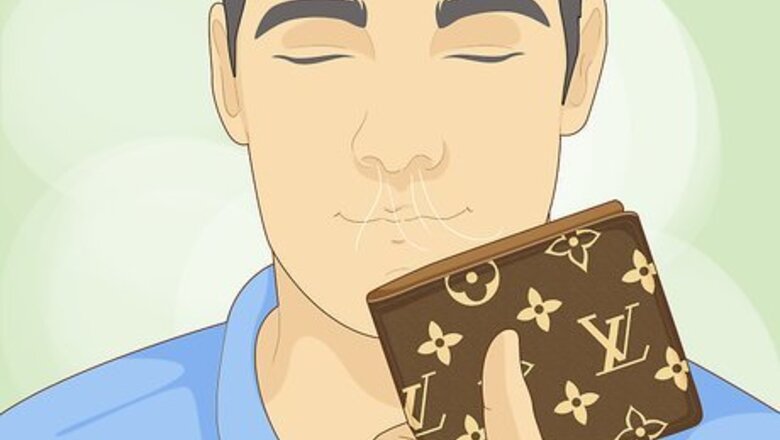
views
- Authentic Louis Vuitton wallets are made of sturdy leather. Fakes may smell like plastic or chemicals.
- Ensure hardware like zippers are made of metal and have the LV logo.
- Designs that intersect or get cut off across seams typically indicate a fake Louis Vuitton wallet.
Inspecting the Wallet Quality

Feel and smell the wallet to confirm that it's real leather. LV wallets should be made of real leather unless the product description says otherwise. The wallet should feel and smell like pure leather. If it smells like chemicals or plastic, then it isn’t an authentic wallet. The leather should feel dry, not oily or sticky. This could indicate a synthetic product or damage.
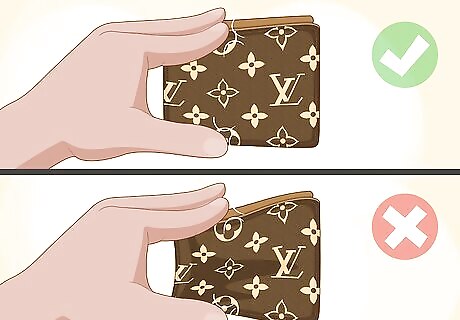
Squeeze the wallet to check for a thick structure. Authentic LV wallets are usually thicker than counterfeits because they’re made of sturdier material. Feel the wallet to make sure it’s thick and doesn’t feel flimsy. Fakes will feel like plastic and nowhere near as sturdy. The structure might not be immediately obvious to you without something to compare the wallet to. Use the structure combined with other indications to spot fakes.
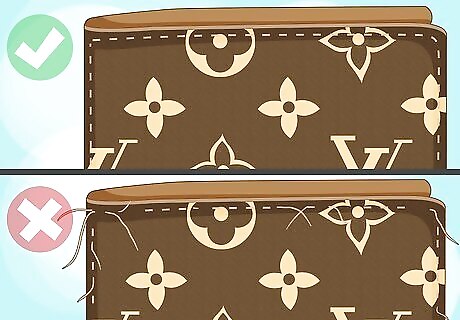
Look for flawless and even stitching around the entire wallet. LV products are all held to the highest quality standards. Look at the stitching along the border of the wallet. All of the stitches should be in a perfectly straight line and an even distance from each other. Any inconsistencies or imperfections indicate a counterfeit because LV wouldn’t put out a product that had these mistakes. Look closely at the corners. It takes a lot of skill to keep the stitching straight around turns or corners, and counterfeiters usually mess up here.
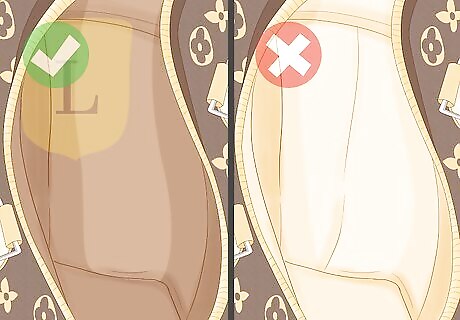
Make sure the interior is as well-made as the exterior. Check inside the wallet on areas that aren’t immediately visible. An authentic LV product will have perfect stitching and sturdy materials everywhere, but a counterfeiter might try to hide imperfections inside the wallet. Some line the interior of wallets with fabric instead of leather, or try to hide poor stitching behind flaps.
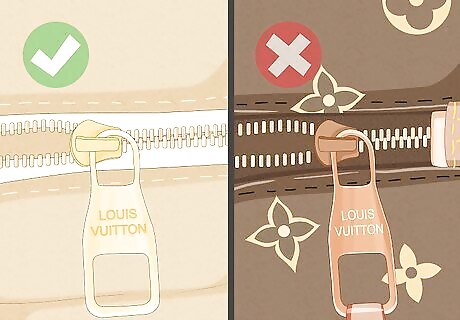
Touch the zippers and other hardware to make sure they're quality metal. Counterfeiters often use cheaper materials for the wallet hardware. Sometimes they even use plastic. Hardware on authentic LV products should feel heavy and sturdy, and look shiny. If the hardware looks faded or feels light, then it's probably fake. Authentic LV zipper pulls are gold with a soft matte finish. Zippers should glide easily without the use of force. Some LV women's wallets come with chains. Remember to inspect this chain for quality as well. LV usually stamps its logo on the hardware as well. Counterfeiters might skip this step, or they might use low-quality stamping methods that produce a faded and imprecise logo.
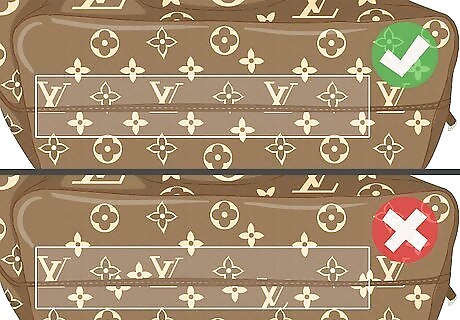
Confirm that the base color doesn’t bleed through any colored designs. LV occasionally releases products with colorful designs like flowers. These designs should look flawless and have vibrant colors. None of the base color should show through the design. Counterfeits usually cheaply stamp the design on, so the colors fade over time. If any of the designs look faded, then this indicates a fake. Usually, designs don’t cross over seams. If any of the designs are intersected or cut off, this also indicates a fake.
Checking the Logos and Codes
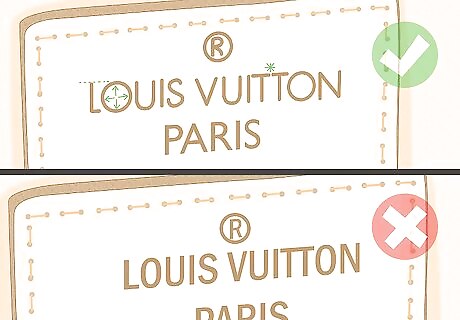
Check the letters and spacing on the Louis Vuitton logo. The LV logo appears on the wallet product stamp, and might also be on the front or back of the wallet cover. This logo is very precise, and many counterfeiters can’t reproduce it correctly. If the logo on a product you’re looking at doesn’t look exactly right, then don’t buy it. If you’re unfamiliar with the LV logo, check their website or even do a Google image search for a side-by-side comparison. The “L” in the logo has a very short tail. If it looks like a standard L, then it’s probably a fake. The O’s are also very round and look larger than the other letters, while the tops of the 2 T’s nearly touch each other. There are some exceptions to this rule for special or limited releases. Letters in each word are all close together, but there is a space between both words. Some counterfeits omit this space and make Louis Vuitton look like one word. The genuine logo looks very crisp and is easy to read. If it looks faded, unclear, or uneven, then this is a bad sign.
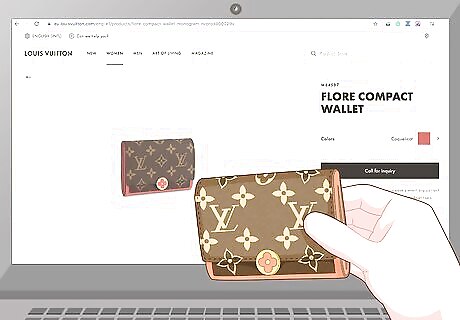
Compare the wallet to the same model on Louis Vuitton’s website. All of Louis Vuitton’s products are listed on their website. If you have any doubts about what a wallet is supposed to look like, go to https://eu.louisvuitton.com/eng-e1/homepage and find the wallet you’re looking at to compare. Pay close attention to the logo placement on this specific product. A counterfeiter might get this small detail wrong.
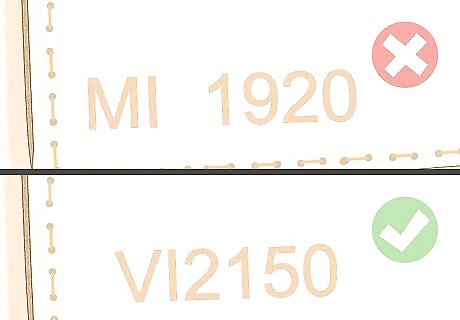
Identify the date code on the inside of the wallet if it has one. In 1987, Louis Vuitton started adding country and date codes to some products. This code may be on a tab inside the wallet or directly stamped onto it. You can look up this code to see if it’s accurate. LV doesn’t have a public key to look up codes, but if you search a code on the internet you’ll find other websites that can interpret the code. Unlike some other designer brands, LV bags and wallets do not have serial numbers. A date code isn’t the same as a serial number, so they’re not unique to any one product. LV doesn’t put a lot of emphasis on the code in determining a real from a fake product, as some newer products no longer come with a date code. Having or not having a date code doesn’t confirm whether a wallet is real or fake. A real code may have rubbed off, or a counterfeiter may have stamped a correct code onto the wallet. However, if there is a mistake in the code, like if you get an error message in a search tab, then it’s definitely fake.
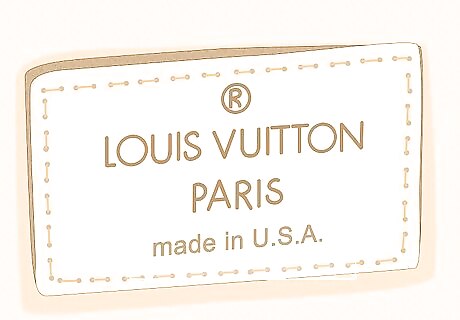
Look up where this particular wallet was manufactured on LV's website. Since most Louis Vuitton products are made in France, counterfeiters usually slap “Made in France” on all their products automatically. However, LV has workshops in a few different countries. They also occasionally release special lines or collaborate with other companies, and these products might be made elsewhere. Look on the LV website to confirm where a particular line was manufactured. If it was produced somewhere other than where the stamp says, then this is a fake product. LV leather products like wallets are all manufactured in France, Spain, or the US. Some other products are made in Switzerland and Italy.
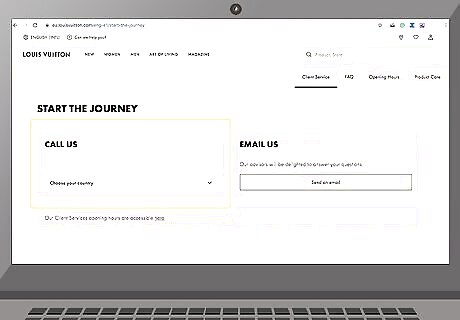
Contact Louis Vuitton client services if you need any assistance. Louis Vuitton prides itself on producing quality products and doesn’t want consumers to buy fakes. If you’re unsure if a product is authentic, then contact LV directly and ask for help. Their representatives can help you assess the piece and decide if it’s authentic or not. You can call or email client services by visiting https://eu.louisvuitton.com/eng-e1/contact-us. Asking the company about fakes also helps them because they can then report counterfeiters to the correct authorities.

















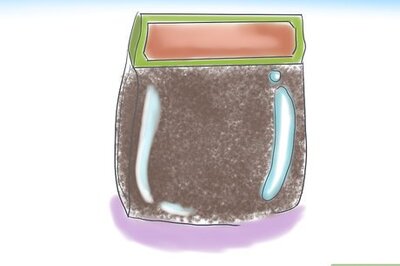
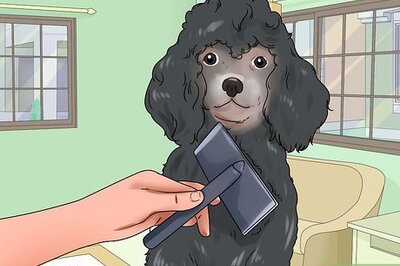

Comments
0 comment